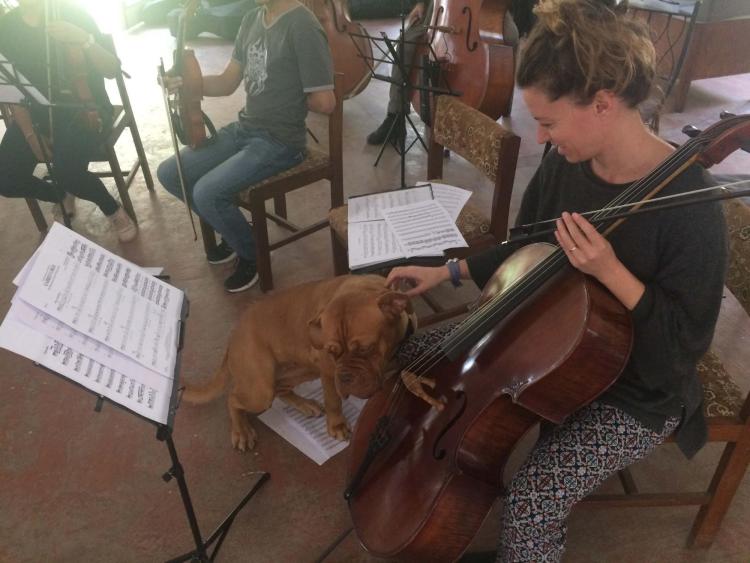Revelations in the Himalayas
Nicholas Carthy has been conducting for more than 35 years. An accomplished pianist and a trained violist himself, there isn’t much you can teach the Eklund Opera Program music director about leading a group of seasoned musicians through the rigors of a Mozart opera or a Tchaikovsky overture.
But what if the group of musicians … isn’t seasoned at all?
“Then you have to revisit things you may have forgotten.”
That’s just what Carthy did last fall, when he spent 10 days working with a group of newly minted adult musicians in the back room of a bar in Kathmandu, Nepal. The group—who Carthy met and quickly befriended during his regular stint as a guest teacher at Toppenkurset International Summer Academy and Festival in Norway—had just started an orchestra from the ground up. They invited Carthy, his wife and College of Music alumna Anne Ristorcelli (MM ’10), and their daughter Emmy—herself a talented violinist—to be involved in the early stages.
Carthy says it was a perfect opportunity to pay it forward and share his love of music. But first, he needed to get to rehearsal.
Gentle chaos

“Most of the security personnel had never even seen a violin up close, let alone all the parts that make one up,” Carthy remembers. “They looked at the tail pieces and pegs—and all these strangely shaped pieces of wood—and said, ‘What’s this?’”
Carthy and Ristorcelli had two violins with them, to be exact, along with about 30 sets of strings and countless pieces and parts they planned to donate to the fledgling musical group to help them get started.
“Once we got past security, we were welcomed in the traditional Nepalese fashion, with garlands of flowers and red dabs on our foreheads. It was all very generous,” Carthy says.
After the airport, it was an hour and a half in the car to get through the choked traffic of Kathmandu, the Nepalese capital in the shadow of the Himalayas known for its heavy pollution and crowded streets. The trip was exhausting—but Carthy says it’s an everyday reality for the members of the upstart orchestra.
“The whole thing had this wonderfully gentle chaos about it. Nobody got fraught when someone was late or wondered where anyone was. This was their life.
“Everyone had other jobs and commitments, but they were all really determined to make this work.”
The group Carthy worked with was led by Sanjay, a teacher. The musicians themselves were a far cry from what Carthy encounters at the College of Music: Many of them learned to play by watching YouTube, some of their instruments were barely functional, and most of them had only picked up a bow for the first time as adults.
They were new to all of it. So Carthy changed his approach.
“What I was doing wasn’t working so I had to adjust to meet them. We would hold one or two rehearsals a day and the rest of the time we talked about how to lead an orchestra, how to make sure your bow is in the same place as everyone else’s—even who turns the page and where you sit.
“I had to go back to the absolute basics of what I was doing.”
Square one
In addition to two daily rehearsals, Carthy led the group in classes on bow placement and instrument repair. Outside the bar, the chaotic hustle and bustle of Kathmandu continued on—sometimes bleeding into the music-making space in the form of curious bystanders—but inside, Carthy took something of a trip back in time.
“I remember when I first started to really listen to Tchaikovsky and the late Romantics as a kid, and I saw that same wide-eyed wonder in these musicians. There’s no substitute for the realization that what you’ve been learning on your own is simply a conduit to something much bigger.”
This artform that Carthy had lived and breathed for most of his life became new again thanks to the childlike reverence of the musicians he led. And the relative age of these adult musicians—just learning music now instead of as fifth or sixth graders—made for a unique experience.
“Music for them is something absolutely enormous,” Carthy says. “You’re coupling a childlike wonder with intellectual maturity.”
After a few days, Carthy began to witness a transformation, both in what the orchestra was giving him, and in what the musicians needed from him in return. “The most rewarding bit was that you saw this organism come to life, and by the end of the week they knew how to play without me being autocratic about the beat.”
Just as Carthy was able to give back to these new musicians, he says they saw the opportunity to pay it forward as well.
“We held a concert at the end and raised money for a group of us to trek into the Himalayan foothills next year, where we’re going to take instruments to remote villages.
“I shared my privilege with them, and they in turn are going to share theirs.”

Above all
Before leaving Kathmandu, Carthy and the group spent a morning above the smog of the million-person city, getting a glimpse of Everest and K2 from a sightseeing gondola. “Most of them had never been up there before. It was tear-inducing to see that sight, and to see them see it for the first time.”
It brought Carthy’s time in Nepal—and in the other countries where he made music during his sabbatical year—full circle.
“We were in the north of Russia, working with a new youth orchestra in Petrozavodsk, and we went to Taiwan to work with a school orchestra who already played brilliantly. I ran the gamut between the very beginning to the very advanced.
“I brought that back, that having to question what I do in a technical sense.”
At the end of the day, Carthy says he came back a stronger educator and maestro.
“Introducing something you’ve loved all your life to people who will now love it all their lives, too … you can’t get a better experience than that.”


